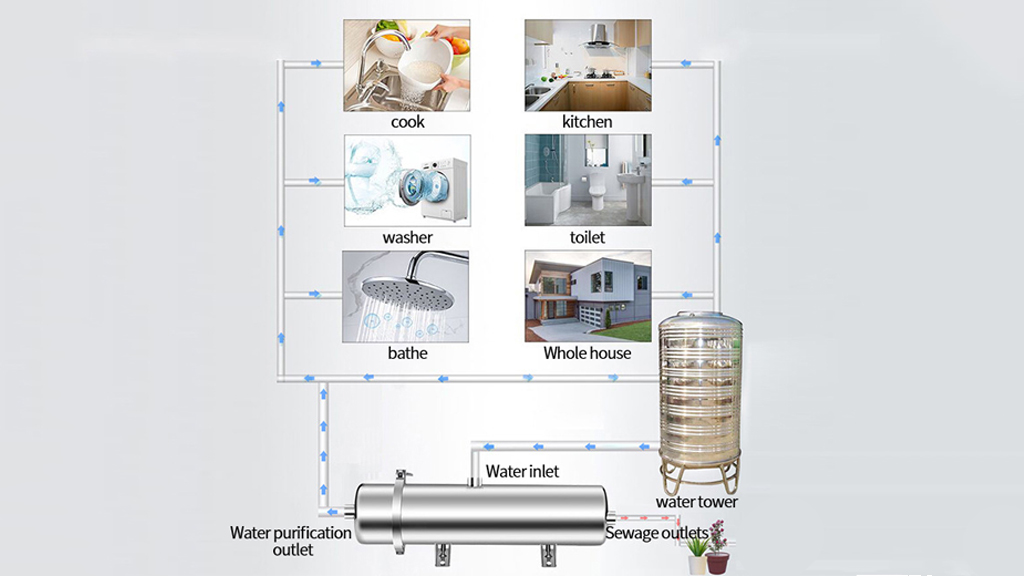WhatsApp/Wechat:+86 133 1731 6659
Understanding the Necessity of Water Filtration
Water is essential to our daily lives, but the water supplied to our homes isn’t always as clean as we’d like. Contaminants like chlorine, lead, and sediment can find their way into our water supply, affecting both taste and health. A whole house water filter system offers a comprehensive solution by treating water at the point of entry, ensuring every water source in your home delivers cleaner, safer water.

How Do Whole House Water Filter Systems Work?
These systems typically use multiple stages of filtration. The first stage often involves a sediment filter to remove larger particles like sand and rust. The subsequent stages might include activated carbon filters to adsorb chemicals like chlorine and volatile organic compounds (VOCs). Some advanced systems also incorporate technologies like reverse osmosis or ultraviolet disinfection to eliminate microscopic pathogens and dissolved contaminants.

Key Considerations When Choosing a System
Water Quality Needs
Assess your local water quality report to identify specific contaminants prevalent in your area. For instance, if your region has issues with hard water, a system that includes a water softener component would be beneficial.
Flow Rate and Capacity
A system with an adequate flow rate ensures that water pressure isn’t significantly reduced. Consider your household’s water usage patterns and peak demand times to determine the appropriate capacity.
Installation and Maintenance
Some systems require professional installation, while others are designed for DIY enthusiasts. Maintenance schedules vary, with replaceable filter cartridges typically needing changes every 6 to 12 months.
Popular Brands and Models Comparison
| Brand | Model | Filtration Stages | Flow Rate (GPM) | Key Features |
|---|---|---|---|---|
| Aquasana | Rhino | 3 | 7.5 | Long-lasting filters, easy installation |
| Pentair | UltraFlow | 2 | 10 | High capacity, durable construction |
| GE | SmartWater | 4 | 8 | Smart technology integration |
| APEC | Ultimate | 5 | 6.5 | Reverse osmosis, superior taste improvement |
Installation Process: A Step-by-Step Guide
- Shut Off Water Supply: Locate your home’s main water valve and turn it off to prevent water flow during installation.
- Install Sediment Filter: Connect the sediment filter housing to the main water line using appropriate plumbing fittings.
- Attach Carbon Filter: After the sediment filter, install the activated carbon filter housing, ensuring tight connections.
- Integrate Additional Technologies: If your system includes reverse osmosis or UV disinfection, install these components according to the manufacturer’s instructions.
- Flush the System: Once all components are connected, turn the water supply back on and allow water to flow through the system for 10-15 minutes to flush out any debris or air pockets.
- Test Water Quality: Use a water testing kit to verify that the system is effectively removing contaminants before fully relying on it for household use.
Common Misconceptions About Water Filtration
⚠️ Myth 1: All water filters are the same. In reality, different systems target different contaminants and have varying levels of effectiveness. ⚠️ Myth 2: Bottled water is always safer than filtered tap water. Many bottled water brands simply use filtered tap water and may not have stricter quality controls than your home system. ⚠️ Myth 3: Water filtration systems require minimal maintenance. Regular filter changes and system checks are necessary to ensure optimal performance.
Real-World Applications and Case Studies
In a suburban neighborhood with frequent water quality complaints, residents installed whole house water filter systems and reported significant improvements in water taste and odor. Laboratory tests confirmed a reduction in chlorine levels by up to 95% and a decrease in sediment particles by 80%. Another case involved a family with allergies who noticed a reduction in respiratory symptoms after installing a system with advanced air filtration capabilities.
Maintenance Tips for Optimal Performance
- Keep a maintenance schedule for filter replacements based on manufacturer recommendations.
- Periodically inspect connections for leaks or signs of wear.
- Test your water quality semi-annually to monitor the system’s effectiveness.
Checklist for Implementing a Whole House Water Filter System
- Obtain a recent water quality report from your local municipality.
- Measure your household’s peak water usage to determine required flow rate.
- Research and select a system that addresses your specific water quality concerns.
- Gather all necessary tools and materials for installation.
- Schedule installation during a time when water won’t be needed in the household.
- Set reminders for routine maintenance and filter replacements.
By following this comprehensive guide, you can make an informed decision about implementing a whole house water filter system that meets your family’s needs for clean, safe water.

